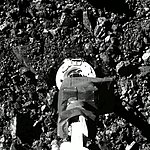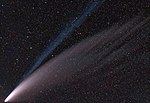2020 PP1 is a sub-kilometer asteroid, classified as a near-Earth object of the Apollo group, that is a temporary quasi-satellite of the Earth. There are over a dozen known Earth quasi-satellites, some of which switch periodically between the quasi-satellite and horseshoe co-orbital states.[6]
Discovery
2020 PP1 was discovered on 12 August 2020 by the Pan-STARRS 1 survey at the Haleakalā Observatory.[1] It was later recovered by the Karl Schwarzschild Observatory in August 2021, which allowed for precovery in earlier Pan-STARRS observations from 24 July 2017.[7]
Orbit and orbital evolution
2020 PP1 is currently an Apollo asteroid (Earth-crossing but with a period longer than a year). Its semi-major axis (currently 1.001715 AU) is similar to that of Earth (0.999789 AU), but it has both low eccentricity (0.07384) and low orbital inclination (5.827°). It alternates between being an Aten asteroid and being an Apollo asteroid, although its orbital evolution is not fully stable and it can be considered as a temporary quasi-satellite of the Earth; its orbital evolution is akin to that of 469219 Kamoʻoalewa.[6]
Physical properties
With an absolute magnitude of 26.6, it has a diameter in the range 10–30 meters (for an assumed albedo range of 0.20–0.04 respectively).[5]
See also
References
- ^ a b c "MPEC 2020-P68 : 2020 PP1". Minor Planet Electronic Circular. Minor Planet Center. 13 August 2020. Retrieved 20 January 2021.
- ^ a b "2020 PP1". Minor Planet Center. International Astronomical Union. Retrieved 3 August 2021.
- ^ "2020 PP1". NEO Exchange. Las Cumbres Observatory. 13 August 2020. Retrieved 3 August 2021.
- ^ a b c d "JPL Small-Body Database Browser: 2020 PP1" (2021-08-01 last obs.). Jet Propulsion Laboratory. Retrieved 3 August 2021.
- ^ a b Bruton, Dan. "Conversion of Absolute Magnitude to Diameter for Minor Planets". Department of Physics, Engineering, and Astronomy. Stephen F. Austin State University. Archived from the original on 23 July 2011. Retrieved 3 August 2021.
- ^ a b de la Fuente Marcos, Carlos; de la Fuente Marcos, Raúl (March 2021). "Using Mars co-orbitals to estimate the importance of rotation-induced YORP break-up events in Earth co-orbital space". Monthly Notices of the Royal Astronomical Society. 501 (4): 6007–6025. arXiv:2101.02563. Bibcode:2021MNRAS.501.6007D. doi:10.1093/mnras/stab062.
- ^ "MPEC 2021-P17 : 2020 PP1". Minor Planet Electronic Circular. Minor Planet Center. 3 August 2021. Retrieved 3 August 2021.
Further reading
- Understanding the Distribution of Near-Earth Asteroids Bottke, W. F., Jedicke, R., Morbidelli, A., Petit, J.-M., Gladman, B. 2000, Science, Vol. 288, Issue 5474, pp. 2190–2194.
- A Numerical Survey of Transient Co-orbitals of the Terrestrial Planets Christou, A. A. 2000, Icarus, Vol. 144, Issue 1, pp. 1–20.
- Debiased Orbital and Absolute Magnitude Distribution of the Near-Earth Objects Bottke, W. F., Morbidelli, A., Jedicke, R., Petit, J.-M., Levison, H. F., Michel, P., Metcalfe, T. S. 2002, Icarus, Vol. 156, Issue 2, pp. 399–433.
- Transient co-orbital asteroids Brasser, R., Innanen, K. A., Connors, M., Veillet, C., Wiegert, P., Mikkola, S., Chodas, P. W. 2004, Icarus, Vol. 171, Issue 1, pp. 102–109.
- A trio of horseshoes: past, present and future dynamical evolution of Earth co-orbital asteroids 2015 XX169, 2015 YA and 2015 YQ1 de la Fuente Marcos, C., de la Fuente Marcos, R. 2016, Astrophysics and Space Science, Vol. 361, Issue 4, article 121 (13 pp).
External links
- Discovery MPEC
- 2020 PP1 data at MPC
- 2020 PP1 at NeoDyS-2, Near Earth Objects—Dynamic Site
- 2020 PP1 at ESA–space situational awareness
- 2020 PP1 at the JPL Small-Body Database











